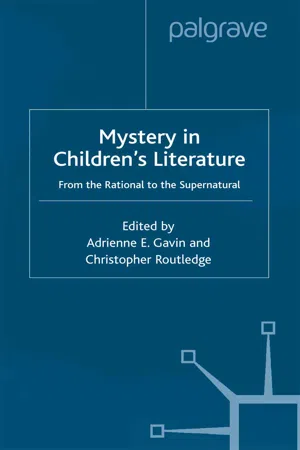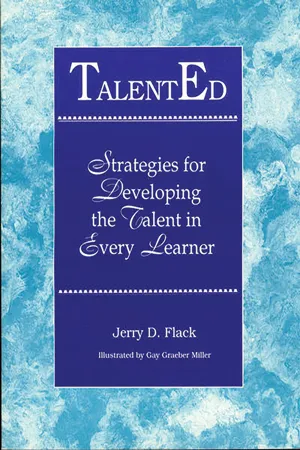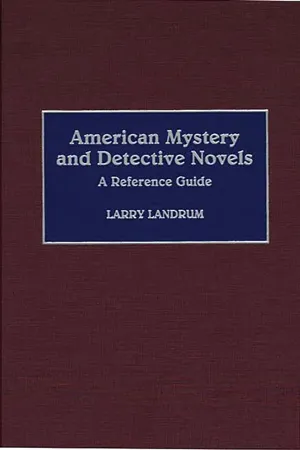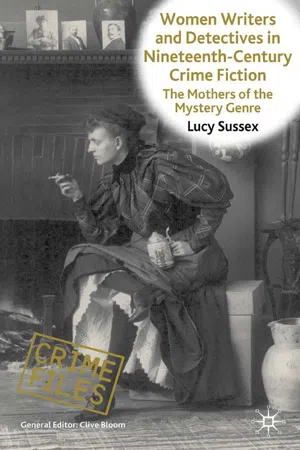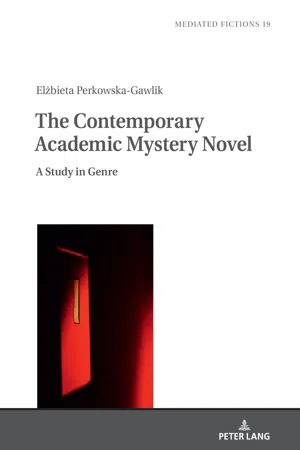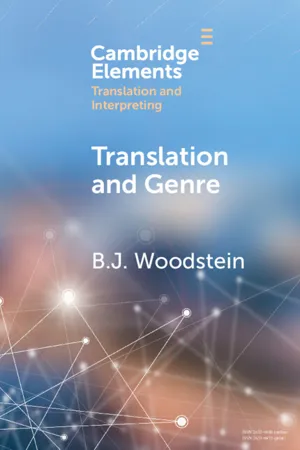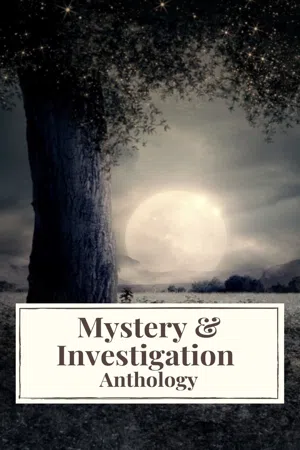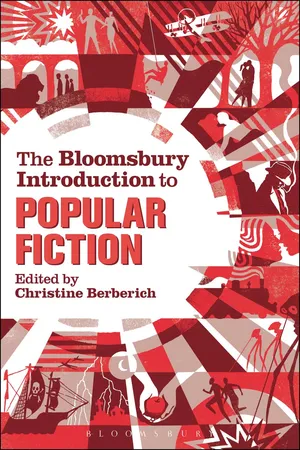Literature
Mystery Novels
Mystery novels are a genre of fiction that typically involve a crime, its investigation, and the process of solving the mystery. These novels often feature a detective or amateur sleuth as the protagonist, and they are known for their suspenseful and engaging plots. The genre has a long history and continues to be popular among readers who enjoy puzzles and suspense.
Written by Perlego with AI-assistance
Related key terms
1 of 5
9 Key excerpts on "Mystery Novels"
- eBook - PDF
Mystery in Children's Literature
From the Rational to the Supernatural
- Adrienne E. Gavin, Christopher Routledge(Authors)
- 2001(Publication Date)
- Palgrave Macmillan(Publisher)
Mystery, then, might be identified as a feature of a particular type of fiction. Yet E. M. Forster goes further, suggesting that it is an integral part 4 Adrienne E. Gavin and Christopher Routledge of the novel as a genre. He writes that mystery ‘is essential to a plot … To appreciate a mystery, part of the mind must be left behind, brooding, while the other part goes marching on’ (88). In other words, mysteries are a fundamental part of successful plot structures. Moreover, Frank Kermode argues, texts can take on a secret life of their own. In The Genesis of Secrecy he discusses the mysteriousness of texts: ‘[o]nce a text is credited with high authority it is studied intensely; once it is so studied it acquires mystery or secrecy’ (144). This, he suggests, coexists with the ‘belief that a text might be an open proclamation, available to all’ (144) and is as true of secular texts as it is of sacred books. The more canonical a children’s text is, we might then argue, the more mysterious it becomes. Frances Hodgson Burnett anticipates such a claim when she writes in the preface to her novel A Little Princess: Between the lines of every story there is another story and that is one that is never heard and can only be guessed at by the people who are good at guessing. The person who writes the story may never know all of it. (n. p.) A word or two should be said about the difference in meaning that the word ‘mystery’ has in American and British contexts. In American usage the word is often synonymous with detective fiction whereas in British usage it encompasses a wider range of meanings which includes detective fiction but also incorporates the spooky, the uncanny, and the in other ways mysterious. The variance may have something to do with cultural differences and trends in writing. - eBook - PDF
TalentEd
Strategies for Developing the Talent in Every Learner
- Jerry D. Flack(Author)
- 1993(Publication Date)
- Libraries Unlimited(Publisher)
As teachers search for methods, materials, and ideas to help them teach these vital life skills to their students, they would do well to examine, the rich possibilities offered through student encounters with the mystery literature genre. Like its cousin, science fiction, mystery literature has been kept in the educational closet too long. The use of mystery literature needs no apology. Freud and Jung are but two intellectual giants who enjoyed mystery literature. Presidents Abraham Lincoln and Franklin D. Roosevelt joined Nobel Prize-winning authors Pearl Buck, T. S. Eliot, Rudyard Kipling, George Bernard Shaw, John Steinbeck, and William Faulkner as writers of mysteries. Mystery literature is highly motivating. More than a few reluctant readers have been successfully engaged in reading and research when introduced to the thrilling adventures of Sherlock Holmes and Doctor Watson, Miss Jane Marple, Hercule Poirot, and a host of other sleuths. Mystery literature addresses critical values essential to a stable society, and may be the most moral of all forms of literature young readers experience. The cardinal rule of all mystery writing is that the guilty are caught and punished. Virtue triumphs over evil; goodness reigns. Moreover, in these modern morality tales, goodness prevails because clever and skillful 129 130 M Is for Mystery detectives use reason and brainpower to uncover wrong and vanquish wickedness and corruption. Unlike so many contemporary television and movie heroes offered up to young people, classic literary detectives such as Jane Marple and Sherlock Holmes bring culprits to justice and right wrongs with mind power, not gun power. Fortunately, classic literature in the mystery genre is widely accessible. The stories of Poe, Conan Doyle, Christie, and others may be easily found for older and more gifted readers. Even at the primary level, many excellent mysteries are available. - eBook - PDF
American Mystery and Detective Novels
A Reference Guide
- Larry Landrum(Author)
- 1999(Publication Date)
- Greenwood(Publisher)
In recent years a great deal of effort has been put into the study of mystery and detective fiction and related genres, providing many new perspectives on how and when these forms emerged and how they are related to culture. The modern mystery grew out of the transformation from the alliance of the aristocracy and religion to capitalism and science. While many structural similarities suggest a common origin for gothic and mystery fiction, mysteries clearly reflect the growing influence of rational explanations of Page xii mysterious conditions that marked early nineteenthcentury popular literature. The gothic element in many mysteries suggests unexplained factors or the failure of simple causeandeffect reasoning. There is often some sense in which the mystery threatens to escape rational explanation. Such uncertainty is expressed in other ways: the narrator is vulnerable, caught in a web of intrigue, or susceptible to the frailties of ordinary people. The central figure of a mystery is often the narrator, and the weight of suspense allows little distance between the narrator and the reader. In the early detective story, especially, narrative distance is established by focusing the reader’s attention more or less on detection and often by placing a recorder of the experience—a Watson figure—between the reader and the detective. Detective stories are more specific than mysteries. They focus the narrative more directly on the solution of a puzzle that the solution of a crime poses. Detective stories demand keen observation, superior reasoning, and the disciplined imagination of their protagonists. The immediacy of physical danger may require a strong arm, fighting skills, or a quick gun or may be swept away by the furtive investigations of some frail, elderly sleuth or even by a child. In any case the narrative must provide suitable challenge with high enough stakes that the measures taken by the detective seem appropriate. - eBook - PDF
Detective Fiction and The African Scene
From The Whodunit? To The Whydunit?
- Linus Asong(Author)
- 2012(Publication Date)
- Langaa RPCIG(Publisher)
Although it is hard to find an airtight and really comprehensive definition of most literary concepts, the concept of the genre as commonly presented to the public is quite often too narrow or too wide, even when this is done by people whose attitude towards the works is positive. H. Douglas Thomson (1962:129), described by Howard Haycraft as the “first major historian anywhere on contemporary police romance as living 11 literature,” defines it as “a problem; a dramatic problem, a ‘feather to tickle the intellectual.” S.S. Van Dine (1974:17) (Williard Huntington Wright) says: The detective novel does not fall under the head of fiction in the ordinary sense, but belongs rather in the category of riddles: it is, in fact, a complicated and extended puzzle cast in fictional form. Its widespread popularity and interest are due, at bottom and in essence, to the same factors that give popularity and interest to the cross-word puzzle. These statements and many more which stress only the puzzle element in the works, may be ideal for a book-seller or a librarian in classifying works on the shelf. But as definitions, they fail in that they only serve to emphasize the distance between the genre of detective fiction and the so-called “serious literature.” As a viable division of literature, the least that can be said about the best example of it is that it is a full-length work of fiction in which the writer arouses and sustains interest by employing every possible requirement of good writing in the investigation and solution of the mystery surrounding a crime. This way, the gap between good detective fiction and good literary fiction can be seen to be a very narrow one. Purpose of Literature of the Genre The purpose which detective fiction is generally believed to have been created to serve - that of temporary “escape” from frustrations of life, or vicarious experience - is another major cause of the disgrace the genre continues to suffer. - eBook - PDF
Women Writers and Detectives in Nineteenth-Century Crime Fiction
The Mothers of the Mystery Genre
- L. Sussex(Author)
- 2010(Publication Date)
- Palgrave Macmillan(Publisher)
This process began very early; in 1817 George Ludlum turned the recent death of Mary Ashford into The Mysterious Murder: or, What’s the Clock? Yet melodrama partook of other forms than crime reportage, its initial inspiration being the contemporary publishing sensation of the Gothic novel: Pixérécourt adapted Ann Radcliffe’s 1794 The Mysteries of Udolpho for the stage. The Gothic might seem remote from the sordid details of contemporary true crime, with its exotic/historic landscapes, swash- buckling villains and persecuted heroines. However, it was the Gothic that supplied the word ‘mystery’ to the crime genre. The term had a his- tory of wandering between literary genres, denoting in medieval times a biblical play. By the late eighteenth and early nineteenth centuries it connoted the Gothic, frequently appearing in titles such as the afore- mentioned The Mysteries of Udolpho. During the nineteenth century the meaning of the word is various, Les Mystères de Paris (1842–3) by Eugène Sue, the unfinished The Mystery of Edwin Drood (1870) by Dickens and The Mystery of a Hansom Cab being three novels with similar titles but major differences. Only the last example is indisputably what we would term a modern mystery novel: structurally dominated by a crime and its solution. The Gothic is a Pangea of genre literatures, containing within it the future continents of horror, science fiction (as with Mary Shelley’s Frankenstein) and crime writing. Behind the romantic history, the Gothic novel in content is as bloodstained as any Newgate Calendar case – indeed, one early Gothic novelist, Charlotte Smith, translated The Beginnings of Crime Fiction 19 selected tales from Pitaval with the telling title of The Romance of Real Life (1787). Yet perhaps more crucial is what mystery involved in the Gothic context: the depiction of a sensational motif or incident, with its explanation being delayed until much later in the narrative. - eBook - PDF
The Contemporary Academic Mystery Novel
A Study in Genre
- Elzbieta Perkowska-Gawlik, Ludmila Gruszewska-Blaim(Authors)
- 2021(Publication Date)
- Peter Lang Group(Publisher)
mystery novel operates on the borderline between conventions of the detective novel and the academic novel, one may assume that the ideal audience’s knowledge and expectations encompass the characteristics of these two conventions simultaneously� 18 The present analysis is an expanded and developed version of my article “Character in the Academic Mystery Novel: Joanne Dobson’s The Raven and the Nightingale” included in Characters in Literary Fictions (2015)� 19 Roman Jakobson understands the dominant “as the focusing component of work of art [which] rules, determines, and transforms the remaining components (Newton 26)� - eBook - PDF
- B. J. Woodstein(Author)
- 2022(Publication Date)
- Cambridge University Press(Publisher)
and of course a detective; police procedurals, which show the workings of the police; thrillers, which show ‘threats to the social order, heroes and villains, and deduction and resolution’; and several other types, including ‘female sleuth, GLBT [sic] sleuth, historical mysteries, locked door mysteries’ and so on (Appalachian State University 2019, n.p., sic). Bradford offers a definition of thriller as a text that ‘is characterized by the exaggeration of acts and character- istics that enable the reader to exchange anything resembling credulity for fantasy and escapism’ (2015, p. 103), and he also adds horror as one possible subgenre (2015, p. 110) and legal as another (2015, p. 112). Heather Worthington includes children’ s crime fiction and feminist crime as additional categories (2010, pp. 97, 108). A big question here is whether crime fiction is a subgenre of literary fiction or if it is something else altogether. While I do not wish to engage in non- productive debates about supposedly highbrow literature versus those books considered to be lowbrow, I must pause over the fact that few crime novels are considered canonical and the canon is what tends to be taught and enshrined as classics. Bradford claims that To Kill a Mockingbird is ‘the only crime novel classified unequivocally as a literary classic’ (2015, p. 112). While I am not sure all scholars would agree with this, it is the case that many people view thrillers as ‘commercial’, where commercial is contrasted with literary (e.g. Palmer 1979, p. 69). - eBook - ePub
- Ryūnosuke Akutagawa, Gilbert Keith Chesterton, Wilkie Collins, Arthur Conan Doyle, Hanns Heinz Ewers, Hollis Godfrey, Thomas Hardy, William Le Queux, Maurice Leblanc, Gaston Leroux, Catherine Louisa Pirkis, Edgar Allan Poe, Frank R. Stockton, Mark Twain, Jules Verne, Carolyn Wells, Fred Merrick White(Authors)
- 2021(Publication Date)
- Icarsus(Publisher)
"Therefore, when we speak of the detective story, and regard it seriously, we do not mean the penny-dreadfuls, the dime-novels, and the books which are hastily thrown together by some hack-writer of the 'Nick Carter' school, but the skillfully planned work of one who can construct and work out a complicated problem, definitely and convincingly. It must not be too complex; for here, as in all art, simplicity is the soul of genius. The story must appeal to our love of the mysterious, and it must be characterized by ingenuity, without transcending in the least the limits of the probable."This is a clear and rational definition of the Detective Story as we propose to consider it, and it seems to justify the acceptance of such stories as literature. But even in the complete absence of necessity for apology, we must consider the rightful place of the Mystery Story in fiction.It is neither below nor above other types of story, but side by side with character studies, problem novels, society sketches or symbolic romances; and in so far as it fulfils the requirements of the best literature, just so far it is the best literature.There are bigoted and thoughtless critics who deny the Mystery Story any right to be considered as literature at all. But better judges are better pleased. To quote from a personal letter of Mr. Arlo Bates:"As to whether a Detective Story is literature, it seems to me that the question is not unlike asking whether a man with blue eyes is moral. No story ever took a place as literature on the strength of its plot. I am in the habit of telling my classes that one can no more judge the literary value of a novel from its plot, than one can judge of the beauty of a girl from an X-ray photograph of her skeleton. To exclude detective tales would be greatly to diminish the world's literary baggage."Professor Brander Matthews tells us in "Inquiries and Opinions" that "Poe transported the detective story from the group of tales into the group of portrayals of character. By bestowing upon it a human interest, he raised it in the literary scale."But Mr. Matthews continues: - Christine Berberich(Author)
- 2014(Publication Date)
- Bloomsbury Academic(Publisher)
Such a – dare we say it? – soft-boiled approach to the genre has been so successful that McCall Smith has transplanted it back to Scotland in his Isabel Dalhousie mysteries, whose compassionate lament for the decline of civility in contemporary Edinburgh is miles away from the harsh grittiness of the Tartan noir. This is further proof of the extraordinary variety available within crime writing, a literary category of such suppleness as to warrant being called an ‘unclassifiable genre’ (Scaggs 2005, 1). The perfect detective novel is not the one that best follows the generic rules, as Todorov has claimed (1977, 43): rather, crime writing keeps its hold on readers for its ability to adapt to changing social and cultural conditions, all the while flaunting its contradictions, as it continues to surprise us. Notes 1. The connection between detective fiction and a spiritual dimension is reiterated by Nicholas Blake who suggests that the rise of the genre compensates for the ‘decline in religion at the end of the Victorian era’ (1946, 400). Blake is the pseudonym under which Cecil Day-Lewis wrote detective fiction and criticism. 2. Unsurprisingly, both W. H. Auden and Nicholas Blake think of the genre as the escapist literature of choice for intellectuals. On his part, Todorov also subscribes to the elitist prejudice against genre writing by arguing that mystery stories which do not conform to the formula become ‘literature’ and not ‘detective fiction’ (1977, 43). 3. Ellery Queen is the pseudonym adopted by Frederic Dannay and Manfred Lee, who published their first detective novel, The Roman Hat Mystery , in 1929. 4. Often mentioned as Christie’s fellow queens are Margery Allingham (the creator of Albert Campion in 1929), the New Zealand-born Ngaio Marsh (with her London-based Inspector Roderick Alleyn, first featured in 1934) and Dorothy L. Sayers, whose Peter Wimsey makes his earliest appearance in Whose Body? (1923).
Index pages curate the most relevant extracts from our library of academic textbooks. They’ve been created using an in-house natural language model (NLM), each adding context and meaning to key research topics.
